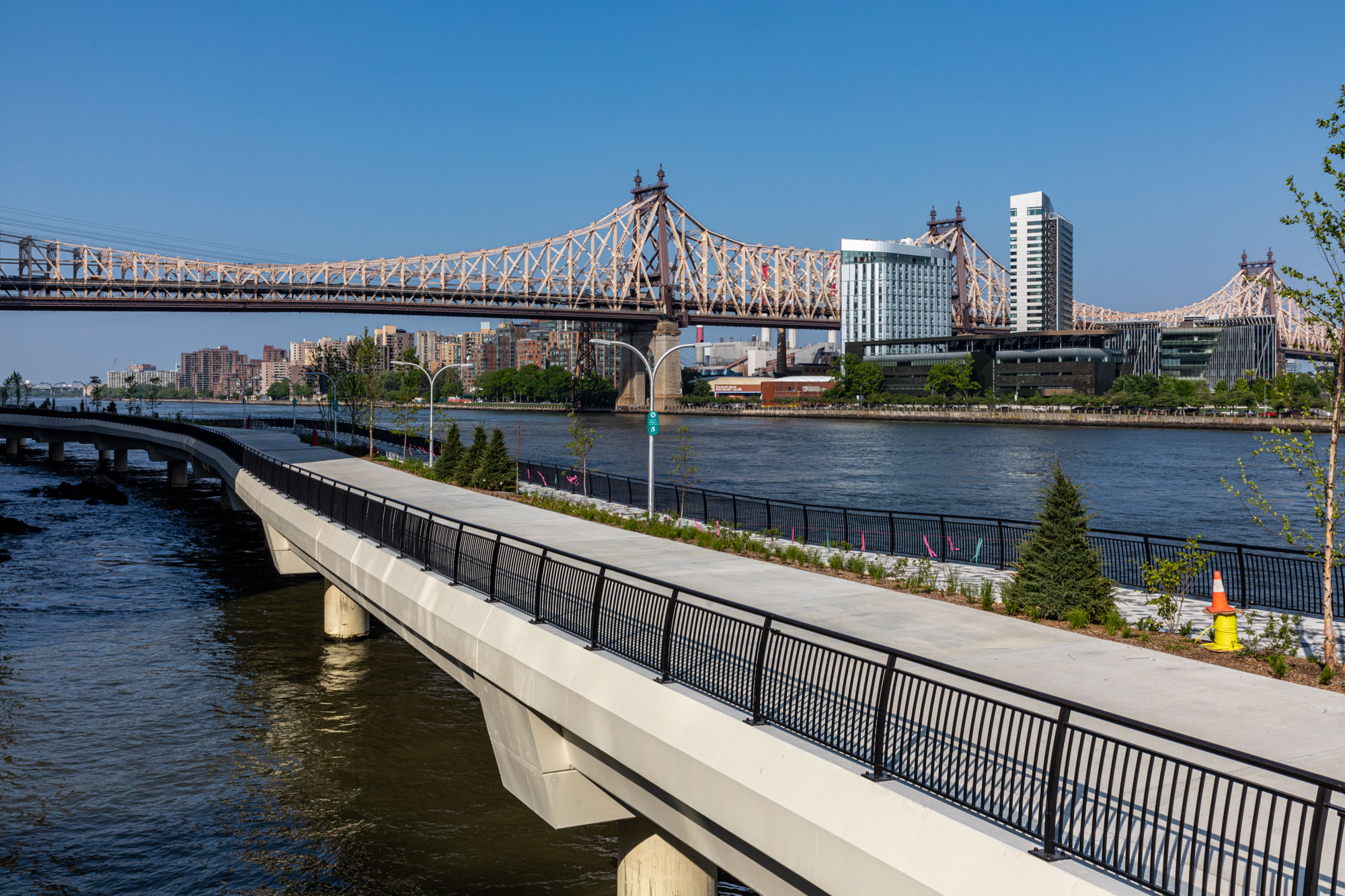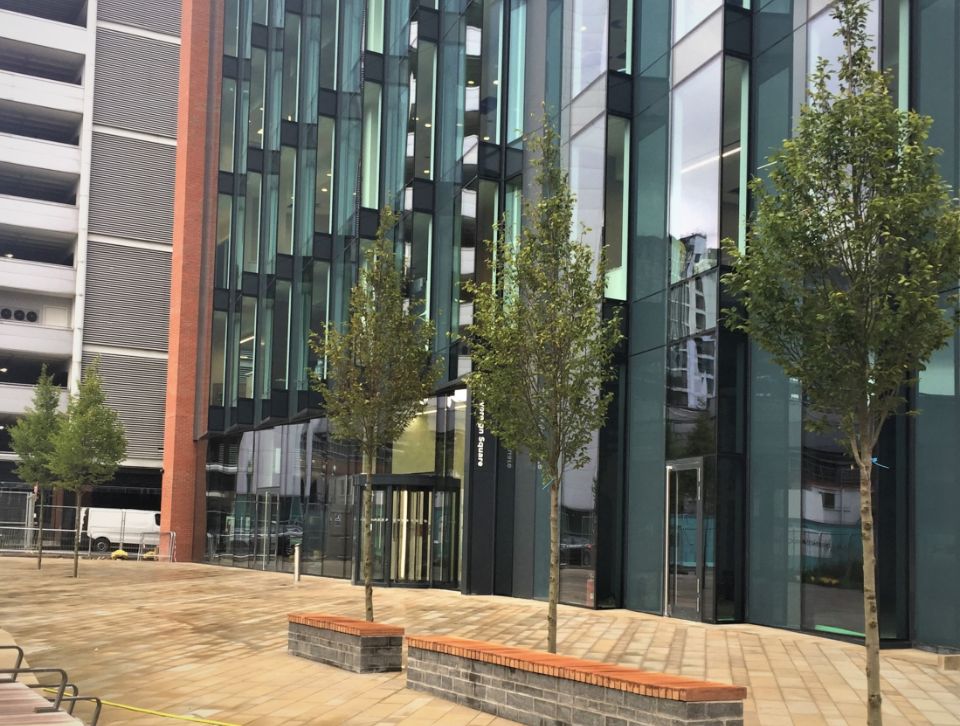Stantec tasked the Silva Cell system with helping grow large esplanade trees by providing a large bank of lightly soil volume

Running from 53rd Street to 61st Street along the eastern edge of Manhattan, the East Midtown Greenway (EMG) — part of the larger East Midtown Waterfront plan, closing the pedestrian loop slated to encircle the borough’s waterfront — is officially opening in mid-December 2023. Stantec led the design and engineering of the ambitious project, prioritizing robust planting and canopy trees from the outset. Stantec and DeepRoot have collaborated on multiple projects in the past, giving the design team a thorough appreciation for the green benefits provided by soil cells, including soil volume and stormwater management: Silva Cells ensure uncompacted soil for healthy tree growth while simultaneously collecting stormwater runoff as passive irrigation before it drains into the East River.
Number of Silva Cells: 867 (1x) and 1,493 (2x)
Shared Soil Volume Total: 50,240 ft3
Number of Trees: 63
Type of Project: Municipal, Waterfront
Project Designer/Engineer: Stantec
Project Contractor: Skanska, Kelco, Brightview
Installation Date of Silva Cells: Fall 2021/Spring 2022


“Closing the gap” was a top priority of project planners in the East Midtown Greenway (EMG) project, a reference to the last section of Manhattan waterfront being made accessible to New York City pedestrians and bikers — a stretch along the East River from 53rd Street to 61st Street (part of a three-phase initiative that runs all the way south to 38th Street). In total, the waterfront project in New York will include 32 miles of continuous, non-vehicular hardscape, encircling Manhattan.
Stantec was selected to design the EMG, a process that began in 2017 with a budget of $100 million. The EMG features three primary components: the top-level bike path and walkway, an in-water structure, and a pedestrian bridge connecting East Midtown to the Greenway. Running 2,000 feet in length, the EMG provides distinct features along the way: a gathering area with stepped and bar seating at the pedestrian bridge landing; a spot to view the remnants of the rocky shore; a bike overlook offering a broad prospect for cyclists taking a pause; a rocky scramble with stepped seats; and a varied and lush planting profile.
Donna Walcavage, landscape architect at Stantec, refers to the EMG as an on-structure linear park and says that “resilience and sustainability were fundamental to the design of the project.” Incorporating significant planting and planning ahead for the effects of climate change were chief objectives. Stantec’s track record of success with the Silva Cell system and DeepRoot’s ongoing commitment to optimizing urban soil, trees, and stormwater management made its adoption in the EMG project an easy decision. Silva cells simultaneously provide uncompacted soil volume for the trees and on-site stormwater collection of the hardscape runoff.


“Although the structure is narrow, it was critically important to provide lush planting and generous shade along the full length of the Greenway,” said Amy Seek, landscape architect at Stantec, who led the landscape design of the project. “So, we coordinated with our engineers to design a structure that could support mature trees and associated soil volume. Silva Cells allowed us to utilize the width of the structure beneath the bikeway for needed soil volume.” Each of the 63 trees were planted in Silva Cells, nearly 2,500 cells in total (both 1x and 2x configurations). The system supports the bikeway hardscape above while below housing more than 50,000 total cubic feet of lightly compacted soil, almost 1,000 cubic feet of soil volume per tree: an amount all but guaranteeing healthy root expansion and thus a long life of health and vitality.
“[Silva Cells] line the entire length of the bikeway. That provides the soil volume needed for trees to thrive, about 800-1,000 cubic feet per tree. The soil cells prevent the soil from compacting — it is a way to protect the soil and hence the trees for the long term. Heat is the number one weather-related killer, so having ample shade along the length of the Greenway structure was a top priority for our design team.”
-Amy Seek
This green strategy has a multi-advantage effect: by prioritizing tree health, the greenway itself becomes a tool in the fight against climate change. Not only do mature trees sequester carbon and improve air quality, but the tree canopies help mitigate the heat-island effect — which, as Seek correctly observes, is the top weather-related cause of death in America.
A diverse array of tree species was planted along the EMG; see below for a complete lineup of the largely native tree selections (63 in total):



The Silva Cells are also being used as a low-impact development (LID) solution for on-location stormwater collection. Seek explains that the EMG utilizes a trench drain that collects rainwater and distributes it into the soil cells beneath the bikeway to ensure that the trees on the project have access to water and are able to thrive. In other words, the runoff is being utilized as a passive irrigation system: as the Greenway’s runoff seeps into the Silva Cells’ soil volume, it serves as supplemental irrigation to the trees; the remaining stormwater filters through the soil before it drains into the East River, a tidal saltwater estuary.
The installation of the Silva Cells also went smoothly, according to Max Jacobson of Steven Dubner Landscaping: “DeepRoot’s technical staff and construction support team were able to assist us throughout the planning, ordering, delivery and installation stages of the contract. One of the largest challenges of the EMG project was shaking out and installing material 2,000 feet onto the esplanade with extremely limited vehicular access. The soil cells were light weight but sturdy, easy to install in mass quantities and flexible to fit the varying site conditions. I would use them again on future projects if the conditions allow us to.”
DeepRoot is very excited to have once again partnered with Stantec to deliver intelligent approaches to infrastructure development — particularly one as valuable and innovative as the East Midtown Greenway.
For other DeepRoot projects in New York City, check out our case studies here, here, and here.
